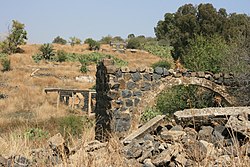User:Maculosae tegmine lyncis/sandbox

Ruins are the remains of failed structures. They are found wherever there are buildings of stone.[2] Deliberate human action and natural disaster, gradual deterioration and neglect are all causes of such structural failure. Ruins provide evidence for the past and are reminders of human mortality. They have inspired numerous writers and artists, since ruin is "part of the general Weltschmerz, Sehnsucht, malaise, nostalgia, Angst, frustration, sickness, passion of the human soul; it is the eternal symbol."[3][4] Their conservation aims to reconcile the competing demands of stability, intelligibility, and authenticity.[5]
Causation
[edit]
Man
[edit]Purposeful destruction of cultural heritage has always formed part of war, since "the first step in liquidating a people is to erase its memory".[7][8] During the Persian Wars, the Greek allies swore "I will not rebuild a single one of the shrines which the barbarians have burnt and razed but will allow them to remain for future generations as a memorial of the barbarians' impiety".[9] WWII[10]
Nature
[edit]Albert Speer Theory of Ruin Value
Imagination
[edit]A ruin "liberates matter from its subservience to form ... form from its subservience to function".[11] Romanticism
Literature
[edit]Although elegy upon ruin is not a major topos of classical literature, Cicero is moved by the ruined walls of Ancient Corinth and is consoled, upon the death of his daughter, by a friend who writes of the once prosperous cities of the Saronic Gulf lying prostrate in ruins before his eyes.[12][13] Pausanias in his Description of Greece invites readers to "restore the ruins in their minds".[14] The Ruin is the first poem on the theme in English.[15] Lines written a few miles above Tintern Abbey "Ruin hath taught me thus to ruminate" Sonnet 64 Petrarch[16] Hypnerotomachia Poliphili
Desolation, dislocation, nostalgia, and lament in a poem in the Man'yōshū by Hitomaro, when he passes the ruins of the former capital: "here were the mighty halls, now it is rank with spring grasses. Mist rises, and the spring sun is dimmed. Gazing on the ruins ... I am filled with sorrow".[17] Li Bai
Art
[edit]
Preservation
[edit]The urge to repair and rebuild may be traced back to biblical times (Isaiah 61:4).[18] Authenticity.[19][20][21]
Stability
[edit]Intelligibility
[edit]stripping of accretions & C19/20 recreation of Roman Forum[22] likewise Parthenon[23]
See also
[edit]


References
[edit]- ^ Lubbock, Tom (6 November 2009). "Great Works: Landscape with Ascanius Shooting the Stag of Sylvia (1682), Claude Lorrain". The Independent. Retrieved 19 July 2012.
- ^ Thompson, M W (1981). Ruins: Their Preservation and Display. British Museum Publications. p. 13. ISBN 0-7141-8034-3.
- ^ Macaulay, Rose (1953). Pleasure of Ruins. Thames and Hudson. p. 23.
- ^ Ginsberg, Robert (2004). The Aesthetics of Ruins. Rodopi. p. 461. ISBN 90-420-1672-8.
- ^ Ashurst, John, ed. (2007). Conservation of Ruins. Butterworth–Heinemann. ISBN 978-0-75-066429-5.
- ^ "FDNY calls for more help". United States Navy. Retrieved 19 July 2012.
- ^ Kundera, Milan. The Book of Laughter and Forgetting. Penguin Books. p. 159. ISBN 978-0-140-06416-2.
- ^ Bevan, Robert (2006). The Destruction of Memory: Architecture at War. Reaktion Books. p. 7, 25. ISBN 978-1-86189-319-2.
- ^ "Against Leocrates 81". Perseus Project. Retrieved 20 July 2012.
{{cite web}}: Unknown parameter|lauthor=ignored (help) - ^ Lambourne, Nicola (2001). War Damage in Western Europe: The Destruction of Historic Monuments During the Second World War. Edinburgh University Press. ISBN 0-7486-1285-8.
- ^ Ginsberg, Robert (2004). The Aesthetics of Ruins. Rodopi. pp. 1, 15. ISBN 90-420-1672-8.
- ^ Cicero. "Tusculanae Disputationes III.53" (in Latin). Perseus Project. Retrieved 20 July 2012.
- ^ Cicero. "Epistulae ad Familiares IV.v.4" (in Latin). Perseus Project. Retrieved 20 July 2012.
- ^ Alcock, Susan (et al.), ed. (2001). Pausanias: Travel and Memory in Roman Greece. Oxford University Press. p. 67. ISBN 978-0-195-12816-1.
- ^ Janowitz, Anne (1990). England's Ruins: Poetic Purpose and the National Landscape. Basil Blackwell. pp. 7f. ISBN 0-631-16756-0.
- ^ Weiss, Roberto (1969). The Renaissance Discovery of Classical Antiquity. Basil Blackwell.
- ^ Levy, Ian Hideo (1984). Hitomaro and the Birth of Japanese Lyricism. Princeton University Press. pp. 114ff. ISBN 0-691-06581-0.
- ^ Jokilehto, Jukka (1999). A History of Architectural Conservation. Butterworth–Heinemann. pp. 4, 10. ISBN 978-0-7506-5511-8.
- ^ Larsen, Knut Einar, ed. (1995). Nara Conference on Authenticity, Japan 1994: Proceedings. UNESCO/ICCROM/ICOMOS. ISBN 82-519-1416-7.
- ^ Larsen, Knut Einar & Marstein, Nils, ed. (1994). Conference on Authenticity in Relation to the World Heritage Convention, Preparatory Workshop, Bergen, Norway, 31 January - 2 February 1994. Norwegian Directorate for Cultural Heritage. ISBN 82-519-1445-0.
{{cite book}}: CS1 maint: multiple names: editors list (link) - ^ UNESCO (2011). "Operational Guidelines for the Implementation of the World Heritage Convention" (PDF). UNESCO. Retrieved 20 July 2012.
- ^ Watkin, David (2009). The Roman Forum. Profile Books. ISBN 978-1-86197-962-9.
- ^ Beard, Mary (2002). The Parthenon. Profile Books. ISBN 978-1861972927.
- ^ Mortier, Roland (1974). La poétique des ruines en France: ses origines, ses variations de la Renaissance à Victor Hugo. Librairie Droz. p. 7.

